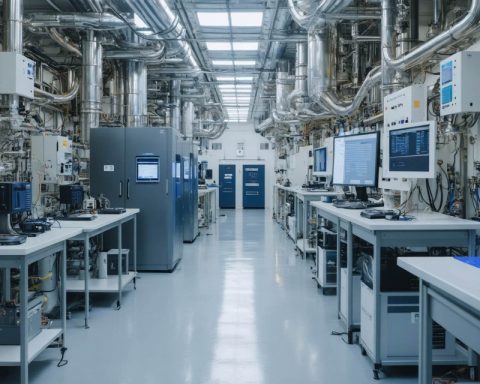- Green hydrogen is the cleanest form of hydrogen fuel, produced through electrolysis using renewable energy sources like wind and solar.
- It emits zero carbon dioxide, playing a crucial role in combating climate change.
- Regions like northern Europe and Australia are leading in green hydrogen production using wind and solar power, respectively.
- Green hydrogen serves as a clean alternative for industries such as steel manufacturing and shipping, significantly reducing carbon footprints.
- Challenges include high production costs and infrastructure limitations, but global investments and technological innovations are promising solutions.
- Countries like Japan and Germany are at the forefront, utilizing green hydrogen for powering technologies and reducing emissions in events like the Olympics.
- Green hydrogen offers a pathway to a sustainable future, essential for restoring balance with nature and preserving the planet.
The winds of change are blowing, powered by the green hydrogen revolution. Picture a world where emissions are as outdated as fossil fuels and where the morning air is crisp and clear. At the heart of this vision lies green hydrogen, a powerhouse of potential, silently transforming the landscape of renewable energy.
What is green hydrogen? It’s the cleanest form of hydrogen fuel, produced by splitting water into hydrogen and oxygen using electricity generated by renewable resources like wind and solar. This process, called electrolysis, emits zero carbon dioxide, making it a critical player in the battle against climate change.
Stroll through the sprawling valleys of northern Europe, and you’ll find massive wind farms electrifying green hydrogen plants. Visualize the coastal regions of Australia, where solar power stretches as far as the eye can see, fueling the production of this renewable marvel. Each facility is a testament to human ingenuity, harnessing nature’s gifts to craft a greener tomorrow.
Why is green hydrogen crucial? Unlike other forms of hydrogen produced from natural gas, green hydrogen emits no greenhouse gases. It holds promise not only as a fuel but as a beacon for industries striving for sustainability. Imagine steel factories and shipping fleets transitioning to this clean fuel, vastly reducing their carbon footprints.
Despite its promise, green hydrogen faces challenges. The production costs are still high, and infrastructure limitations need addressing. But hope is on the horizon. Investments are pouring in globally, and technological innovations are steadily chipping away at these barriers.
Countries like Japan and Germany are leading the charge, banking on green hydrogen to power cities, cutting-edge technologies, and even Olympic events. Their commitment showcases a powerful truth: a sustainable future isn’t just imaginary—it is achievable.
Now, imagine being part of this shift. Picture homes heated with hydrogen, cars zipping around quietly powered by this clean fuel, and industries breathing a sigh of relief as they reduce their carbon footprint. This isn’t just a dream. It’s a rapidly approaching reality.
Green hydrogen isn’t merely a buzzword; it’s a crucial key to unlocking a sustainable future—one where balance with nature is restored and our planet preserved for generations to come. By embracing green hydrogen, we are not just altering our energy systems; we are reshaping our legacy. Let this resonate as a clarion call: the future runs on green hydrogen, and it’s bustling toward us at lightning speed.
The Green Hydrogen Revolution: Unveiling the Future of Clean Energy
The winds of change are blowing, powered by the green hydrogen revolution. Picture a world where emissions are as outdated as fossil fuels and where the morning air is crisp and clear. At the heart of this vision lies green hydrogen, a powerhouse of potential, silently transforming the landscape of renewable energy.
What is green hydrogen? It’s the cleanest form of hydrogen fuel, produced by splitting water into hydrogen and oxygen using electricity generated by renewable resources like wind and solar. This process, called electrolysis, emits zero carbon dioxide, making it a critical player in the battle against climate change.
Stroll through the sprawling valleys of northern Europe, and you’ll find massive wind farms electrifying green hydrogen plants. Visualize the coastal regions of Australia, where solar power stretches as far as the eye can see, fueling the production of this renewable marvel. Each facility is a testament to human ingenuity, harnessing nature’s gifts to craft a greener tomorrow.
Why is green hydrogen crucial? Unlike other forms of hydrogen produced from natural gas, green hydrogen emits no greenhouse gases. It holds promise not only as a fuel but as a beacon for industries striving for sustainability. Imagine steel factories and shipping fleets transitioning to this clean fuel, vastly reducing their carbon footprints.
Despite its promise, green hydrogen faces challenges. The production costs are still high, and infrastructure limitations need addressing. But hope is on the horizon. Investments are pouring in globally, and technological innovations are steadily chipping away at these barriers.
Countries like Japan and Germany are leading the charge, banking on green hydrogen to power cities, cutting-edge technologies, and even Olympic events. Their commitment showcases a powerful truth: a sustainable future isn’t just imaginary—it is achievable.
Now, imagine being part of this shift. Picture homes heated with hydrogen, cars zipping around quietly powered by this clean fuel, and industries breathing a sigh of relief as they reduce their carbon footprint. This isn’t just a dream. It’s a rapidly approaching reality.
Green hydrogen isn’t merely a buzzword; it’s a crucial key to unlocking a sustainable future—one where balance with nature is restored and our planet preserved for generations to come. By embracing green hydrogen, we are not just altering our energy systems; we are reshaping our legacy. Let this resonate as a clarion call: the future runs on green hydrogen, and it’s bustling toward us at lightning speed.
Additional Insights on Green Hydrogen
Market Forecasts & Industry Trends
The demand for green hydrogen is anticipated to skyrocket, with projections indicating a compound annual growth rate (CAGR) of over 14% through 2030. This growth is largely driven by decarbonization mandates and the increasing viability of green hydrogen technologies. According to the International Energy Agency (IEA), global hydrogen production must reach at least 528 million tons per year by 2050 to satisfy the world’s clean energy needs.
Real-World Use Cases
1. Transportation: Companies like Toyota and Hyundai are investing heavily in hydrogen fuel cell vehicles, which emit only water vapor and have ranges comparable to traditional petrol vehicles.
2. Industry: ArcelorMittal and ThyssenKrupp have initiated projects to utilize green hydrogen in steel production, significantly cutting their carbon emissions.
3. Energy Storage: Because green hydrogen can be stored and transported, it offers a way to store excess renewable energy and balance supply with demand when solar and wind are inconsistent.
How-to Steps & Life Hacks
1. Integrating Green Hydrogen at Home:
– Energy Source: Consider installing solar panels to harness renewable energy, which can be used to generate hydrogen.
– Home Fuel Cells: Look into home-based hydrogen fuel cells for power generation and heating. Companies like Bloom Energy are advancing these technologies.
2. Supporting Sustainability:
– Advocate for Policies: Encourage policymakers to invest in hydrogen infrastructure and subsidies for research and development.
– Personal Investments: Explore opportunities to invest in green hydrogen companies or ETFs focused on clean energy.
Challenges and Limitations
– Cost: Green hydrogen production is currently more expensive than gray hydrogen due to the costs of renewable energy and electrolysis technology.
– Infrastructure: There’s a need for new pipelines and storage solutions specifically designed for hydrogen distribution.
– Energy Efficiency: The conversion processes from electricity to hydrogen and then back to electricity can be less efficient than direct electricity use.
Pros & Cons Overview
Pros:
– Zero-emission fuel.
– Versatile energy carrier.
– Large potential for industrial decarbonization.
Cons:
– High initial infrastructure cost.
– Requires a significant increase in renewable energy production.
– Energy conversion efficiencies are still improving.
Quick Tips
– Stay Informed: Keep up to date with hydrogen technology advancements and potential investment opportunities.
– Reduce Carbon Footprint: Support and switch to services or products that utilize hydrogen power.
By staying informed and embracing green hydrogen technologies, individuals and businesses alike can play pivotal roles in transitioning to a sustainable future. For more information on clean energy initiatives, visit the International Energy Agency.














